Typical radiation detectors used to search for radioactive sources or detect radiation hazards by many fire departments and other emergency responders are Geiger counters that measure relatively low levels of gamma radiation. Such detectors saturate and become useless in a high radiation field that might be produced by fallout from a nuclear explosion, a reactor accident, mishandling or release of a strong radioactive source, or malicious release of radiation.
Other types of radiation detectors, such as a silicon semiconductor diode, can measure very high radiation fields, but they are unable to detect the more common weaker sources of radiation. Neither of these detector types is able to measure gamma-ray spectra, which is required to identify the type of radiation source. More sophisticated and very expensive radiation detectors are in use to measure gamma-ray spectra.
The LLNL detector measures radiation over a large dynamic range, spanning both high hazardous levels and weak levels, including natural background radiation. In weak radiation fields, the detector also measures gamma-ray spectra. The cost of the detector is significantly less than the total cost of existing separate detectors that could perform the same measurements.
This universal radiation detector and spectrometer combines the functions of several different instruments in one simple, low power, low cost device. This one device can perform multiple missions without the need to procure separate instruments and train operators for each instrument. The detector can be configured for operation in a fixed location or as a mobile detector. The instrument can be configured for either local or remote readout.
This universal radiation detector and spectrometer combines the functions of several different instruments in one simple, low power, low cost device. This one device can perform multiple missions without the need to procure separate instruments and train operators for each instrument. The detector can be configured for operation in a fixed location or as a mobile detector. The instrument can be configured for either local or remote readout.
The detector has been tested in "breadboard" form, but has not been packaged or configured for a specific application or market.


